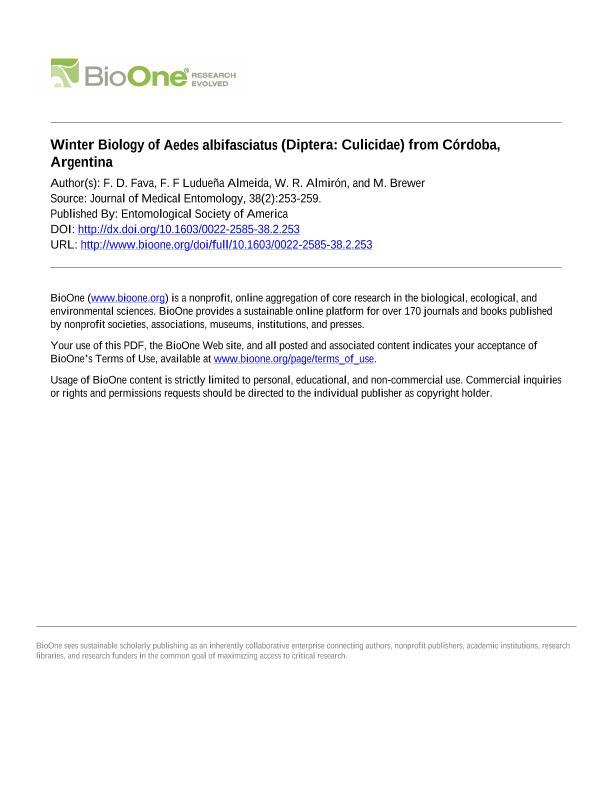Mostrar el registro sencillo del ítem
dc.contributor.author
Fava, F.D.
dc.contributor.author
Ludueña Almeida, Francisco

dc.contributor.author
Almiron, Walter Ricardo

dc.contributor.author
Brewer, M.
dc.date.available
2018-12-19T15:48:34Z
dc.date.issued
2001-03
dc.identifier.citation
Fava, F.D.; Ludueña Almeida, Francisco; Almiron, Walter Ricardo; Brewer, M.; Winter biology of Aedes albifasciatus (Diptera: Culicidae) from Córdoba, Argentina; Entomological Society of America; Journal of Medical Entomology; 38; 2; 3-2001; 253-259
dc.identifier.issn
0022-2585
dc.identifier.uri
http://hdl.handle.net/11336/66752
dc.description.abstract
Host-seeking females of Aedes albifasciatus (Macquart) were collected from April to September 1997, kept under seminatural conditions, and offered sugar solution and blood. Daily survival of females ranged from 0.91 to 0.96, with blood fed females living longer than sugar fed females. Overall, 43% of engorged females completed a gonotrophic cycle, and 15% of them refed and completed a second gonotrophic cycle. The life expectancy of females emerging at the end of summer was longer than those that emerged during winter. Immature developmental time and the developmental threshold were estimated by regression. Embryo development was recorded during autumn, winter, and spring, with a duration of 5-9 d. The developmental threshold for eggs was estimated to be 2.28°C. Egg mortality varied from 0.51 to 0.74. The development time for larva and pupa was between 16 and 29 d and was significantly correlated with temperature. The developmental threshold for larvae and pupae was estimated to be 4.75°C. A greater proportion of females than males emerged when temperatures averaged ≤18°C. Larval and pupal mortality was high at temperatures below the developmental threshold. Aedes albifasciatus females remained gonotrophically active and immature development continued during winter in Córdoba (10°C isotherm).
dc.format
application/pdf
dc.language.iso
eng
dc.publisher
Entomological Society of America

dc.rights
info:eu-repo/semantics/openAccess
dc.rights.uri
https://creativecommons.org/licenses/by-nc-sa/2.5/ar/
dc.subject
Aedes Albifasciatus
dc.subject
Basic Population Parameters
dc.subject
Female Survival
dc.subject
Gonotrophic Cycles
dc.subject
Winter Biology
dc.subject.classification
Otras Ciencias Biológicas

dc.subject.classification
Ciencias Biológicas

dc.subject.classification
CIENCIAS NATURALES Y EXACTAS

dc.title
Winter biology of Aedes albifasciatus (Diptera: Culicidae) from Córdoba, Argentina
dc.type
info:eu-repo/semantics/article
dc.type
info:ar-repo/semantics/artículo
dc.type
info:eu-repo/semantics/publishedVersion
dc.date.updated
2018-11-12T13:44:33Z
dc.identifier.eissn
1938-2928
dc.journal.volume
38
dc.journal.number
2
dc.journal.pagination
253-259
dc.journal.pais
Estados Unidos

dc.journal.ciudad
Lanham
dc.description.fil
Fil: Fava, F.D.. Universidad Nacional de Córdoba. Facultad de Ciencias Exactas, Físicas y Naturales; Argentina
dc.description.fil
Fil: Ludueña Almeida, Francisco. Consejo Nacional de Investigaciones Científicas y Técnicas. Centro Científico Tecnológico Conicet - Córdoba; Argentina. Universidad Nacional de Córdoba. Facultad de Ciencias Exactas, Físicas y Naturales; Argentina
dc.description.fil
Fil: Almiron, Walter Ricardo. Consejo Nacional de Investigaciones Científicas y Técnicas. Centro Científico Tecnológico Conicet - Córdoba; Argentina. Universidad Nacional de Córdoba. Facultad de Ciencias Exactas, Físicas y Naturales; Argentina
dc.description.fil
Fil: Brewer, M.. Universidad Nacional de Córdoba. Facultad de Ciencias Exactas, Físicas y Naturales; Argentina
dc.journal.title
Journal of Medical Entomology

dc.relation.alternativeid
info:eu-repo/semantics/altIdentifier/url/http://www.bioone.org/doi/abs/10.1603/0022-2585-38.2.253
dc.relation.alternativeid
info:eu-repo/semantics/altIdentifier/doi/https://dx.doi.org/10.1603/0022-2585-38.2.253
dc.relation.alternativeid
info:eu-repo/semantics/altIdentifier/url/https://academic.oup.com/jme/article/38/2/253/877362
Archivos asociados
